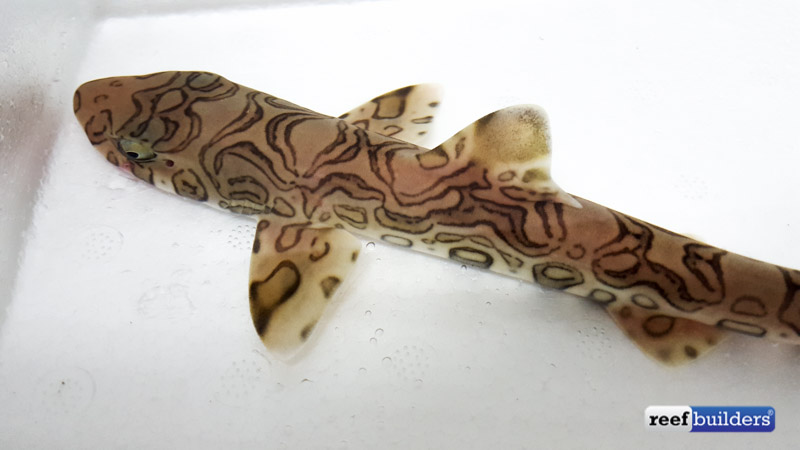The Mandarin Cat Shark is an exciting new species of shark which has just been discovered collected in the northern Philippines. The incredible pattern of the ‘cat shark’ has an uncanny resemblance to the beloved Mandarin goby, and we’ve never seen a shark so beautiful that it made us want to have a nice large shark tank of our own.
Here at Reef Builders we like to focus on the reef and the aquarium side of the hobby, but every now and then, some interesting shark species and specimens will be news worthy enough that we have to take a slight detour from our usual fodder. We’ve covered new species of epaulette sharks, Atelomycterus erdmanni, Hemiscyllium halmahera, and Hemiscyllum michaeli, the birth of albino bamboo cat sharks, and the accidental catch of a nest of chain link cat sharks. But in all of our years, we’ve never seen any shark as sensational as this unknown elasmobranch with the psychedelic pattern of the mandarin cat shark.

To be perfectly honest, we had the most rudimentary grasp of shark taxonomy before we saw the first photos of the Mandarin Cat Shark, but seeing such a sensational pattern on a dwarf shark species motivated us to dive in head first and try to figure out what this particular fish is. After several days of sleuthing we are now infinitely more versed in the specifics of several different shark families, and we’ve come to some conclusions about our gorgeously patterned shark friend here.
For starters, the Mandarin Cat Shark is not a ‘cat shark’ at all, but belongs to a small group of elasmobranchs known as ‘finback cat sharks’. The ‘Finbacks’ include a small number of deep living and bottom dwelling species and belong to the family Proscylliidae. Meanwhile the ‘true’ cat sharks belong to the family Scyliorhinidae and include over 150 species.


Both the finback and true cat sharks are generally ground dwelling and have small adult sizes of three feet or less, but there’s a very easy way to distinguish between the two groups. True cat sharks have a first dorsal fin which is positioned well behind pelvic fins, or directly over them, whereas the finback cat sharks have taller dorsal fins, with the first dorsal fin well ahead of the pelvic fins, almost to the margin. This feature of finback sharks is in full display on this one live specimen of Mandarin finback cat shark we have illustrated here.
There are only six recognized species in the family Proscylliidae, with three genera containing species known as the ‘magnificent cat shark’ and ‘harlequin cat shark’, but neither of those can hold a candle to the graceful and beautiful specimen in focus today. The most similar species of sharks to the Mandarin Cat Shark are the genus Proscyllium whose juveniles share some similarities in pattern to the Mandarin, but significantly different enough that we are confident in labelling the Mandarin as a new species.

The Mandarin Finback cat shark was collected in the Santa Ana region of the Northern Philippines by fishermen employed by RVS Fishworld. The Mandarin Cat Shark was incidentally fished up on a hook and line and brought up from a depth between 160 and 400 feet deep, but carefully brought up over the course of 18 hours! Several specimens were caught by the fishermen to eat or sell in local fish markets, but at least one individual survived the long ascent to the surface.
The new Mandarin Finback cat shark is now alive and well at RVS Fishworld’s main exporting station where it is being observed and conditioned for aquarium life. What makes the Mandarin Cat Shark particularly exciting is its small adult size and the possibility of breeding these fish in captivity.

Proscyllium species have a maximum size of 65cm or just about two feet, but their slender size imparts very little mass to these fish, making them perfect aquarium specimens. The genus has not yet been bred in captivity, but since the sharks are easy to sex and many other smaller species of sharks have been bred in captivity, there’s a real possibility that an individual could acquire a pair and begin their very own breeding program of the Proscyllium sp. “Mandarin”.
But we’re getting ahead of ourselves here, and with this article we’ve thoroughly scratched our itch to know more about this very interesting group of small, benthic sharks. We’ve never seen anything quite like the Mandarin Cat Shark but we’ll keep tabs on this first individual to see how its saga unfolds in the aquarium world.
Update: After we shared these exclusive first pictures of the live Mandarin shark, we received more photos of the shark. Some pertinent phots clearly showed the mouth and underbelly of this exciting shark species, and we have come to a positive identification for this shark, which is a known species.
Hemitriakis complicofasciata is a little known shark species that was only recently described in 2004 with a distribution range that overlaps well with the northern Philippines region where this specimen was caught. Hemitriakis complicofasciata is also known as the ocellate topeshark which still reaches only the modest size of 80cm, or 2.5 feet. The markings on this juvenile shark should change and fade as it grows into adulthood but the degree to which the overall appearance changes is currently unknown. Sincere thanks to Chris Avila of BenthicSharks.ca for helping us come to this positive ID.







